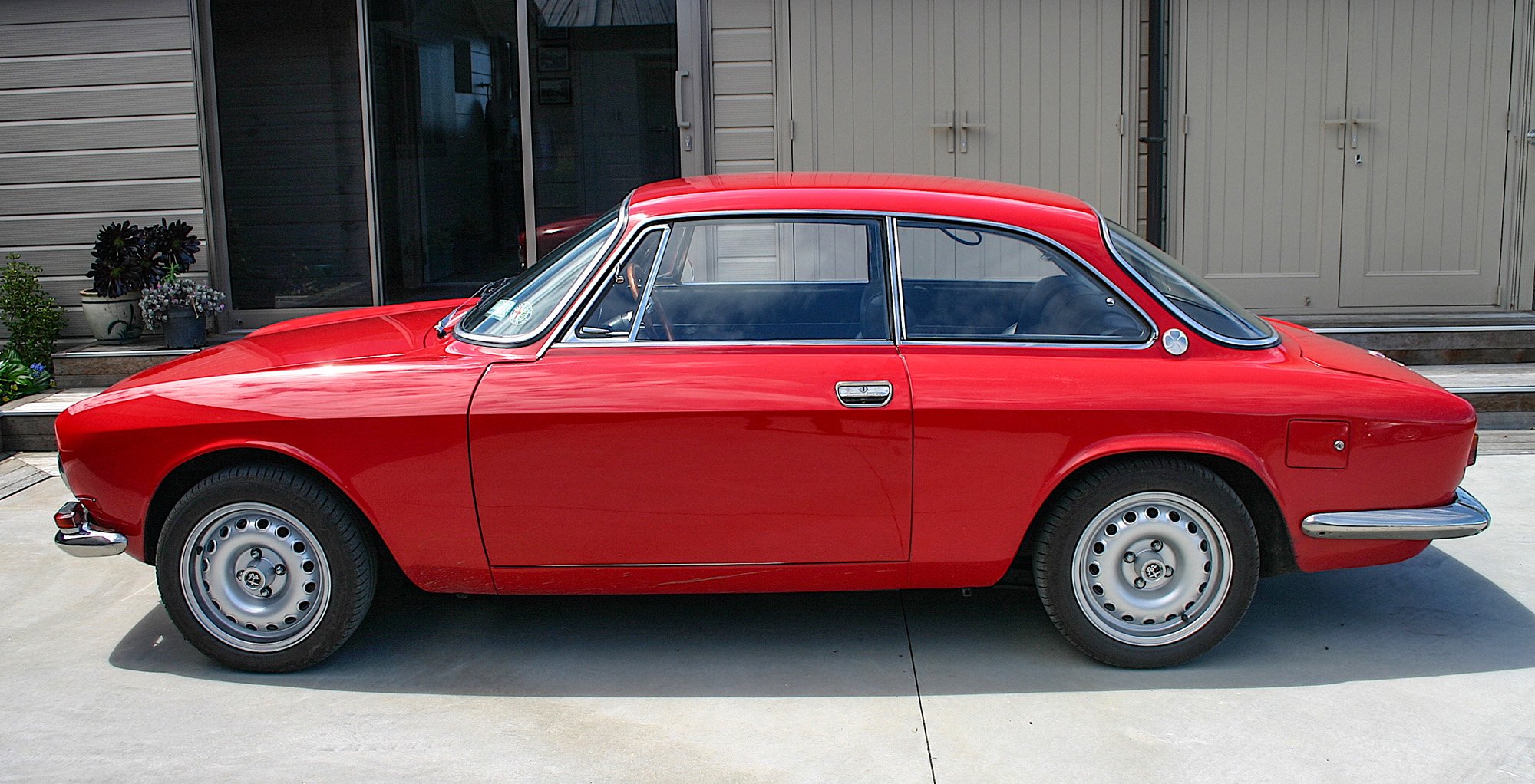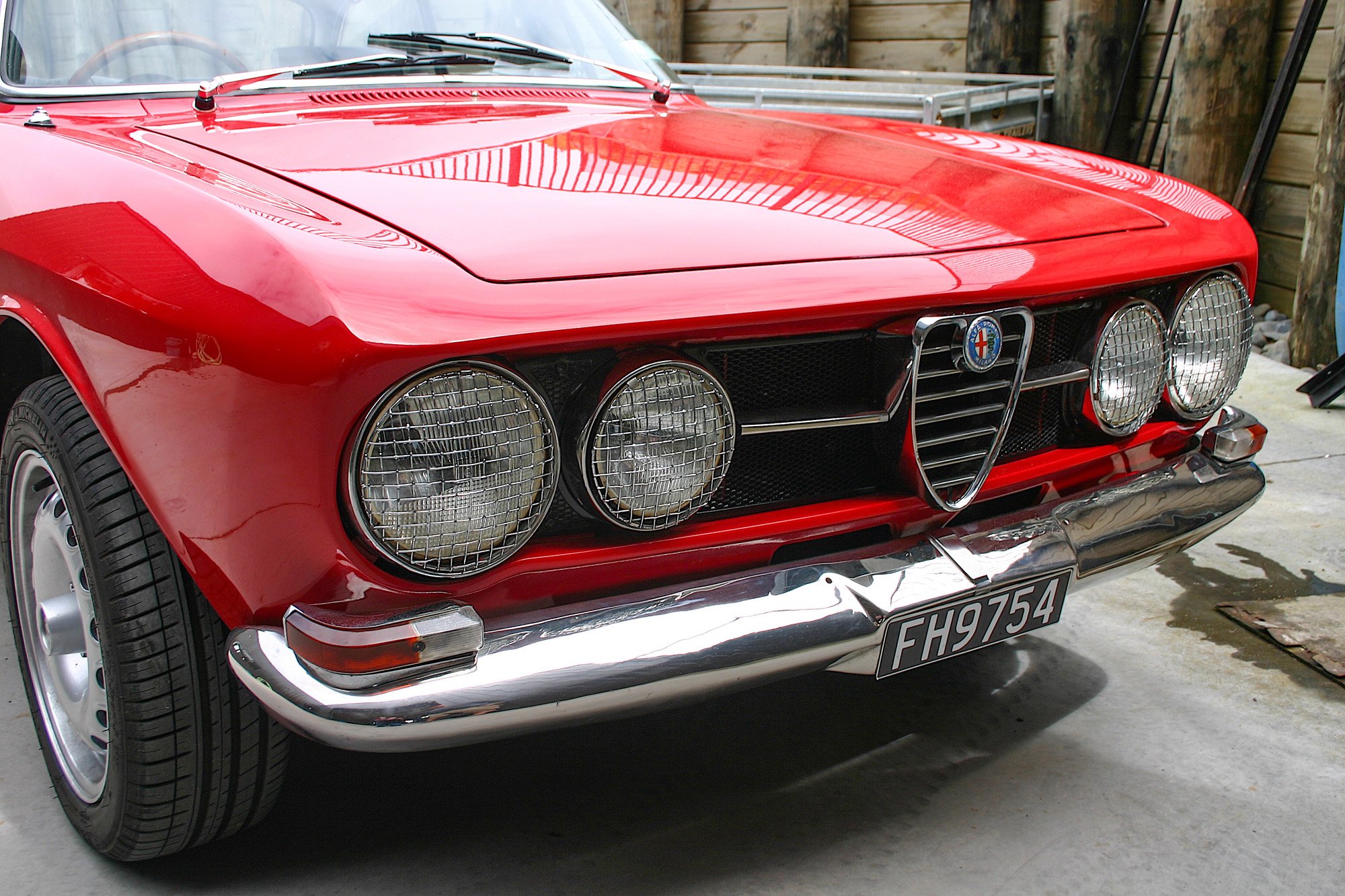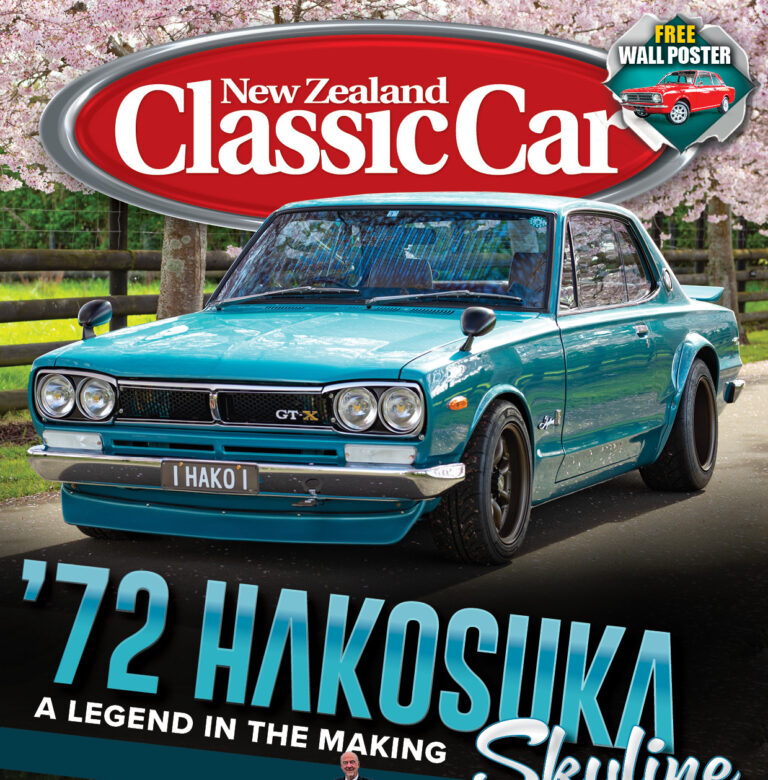The lines of the 1750 GTV are seductive enough, but it’s driving the thing that makes our man fall for Giugiaro and Alfa Romeo’s 1969 masterpiece
Words and photos by Jim Richardson

Bruce Haye, master auto restorer at Ace Panel & Paint in Whitianga, called me the other day and said, “Jim, there is an Alfa here you have to see!” And because Bruce is a mate from way back who has done a couple of show-winning cars for me, that was all I needed to hear. I jumped in my car and headed out. And when I rolled up in front of his shop, I saw it.
Next to Bruce’s gigantic gold 1963 Cadillac Coupe de Ville was an impeccable red 1969 Alfa Romeo 1750 GTV. It was a knockout, and the closer I got the better it looked. Bruce and I chatted a bit and he opened the bonnet. The engine compartment looked better-than-showroom new. Everything about the car was pristine. The paint was flawless; it looked deep enough to walk into, and the fit and finish was dead on.
Brian Webster, the car’s owner, came out next, and we exchanged pleasantries. I then arranged a drive report and photo session for later at Brian’s home. Brian is a big, rugged-looking fellow who is semi-retired from cattle farming. He also has several vintage NSU motorcycles, a lovely 1995 Lancia, and a big, handsome 1972 NSU Ro80 with its original Wankel engine. His home is on the Coromandel with brilliant views of the coast; and there are plenty of quiet, twisty two-lane roads available nearby on which his Alfa can strut its stuff.

Behind the wheel
We jumped in, and I discovered that there was enough headroom for my 18 hand height, and the footwell was reasonably roomy, with the pedals sticking up out of the floor, positioned ideally for spirited heel and toe shifting should the desire overcome you. The dash featured a complete array of bold analogue gauges, arranged to be easy to read at a glance and to make you feel that this is a real driver’s car.
A twist of the key, and the engine came to life with a distinctive throaty twin-cam snarl. The gauges assured me that all was well, and we eased out of the drive and into the street. Visibility was excellent. The clutch was easy and smooth, and the shift lever sticks out of the dash rather than coming up from the floor, thus putting it right at hand. The throws were longish, but shifting was light for its age, positive and precise.
Torque was excellent right from the bottom end up to the red line, and the four-wheel disk brakes responded instantly. The steering was quick and precise, with no hint of understeer, and cornering was flat and predictable, as one might expect from an Alfa Romeo of this vintage. But what was really outstanding was the ride quality. One would expect a choppy, rough ride from a car that handles as well as this one, but bumps were subtle, and the seats were cushy and comfortable even at speed on uneven roads.
The front seats in Brian’s GTV are odd though. That’s because the driver’s seat in his Alfa is really just a passenger’s seat for a left-hand drive version of the car. And that’s because the company made no accommodation for right-hand drive countries such as New Zealand, so the fully equipped flying buttress driver’s seat is mounted on the passenger side, and they are not interchangeable. However, both seats are comfortable.

Bruce Meyer, Mr Mayers
No compromise
Brian’s Alfa 1750 is not an appliance. It is — just as it appears — a sexy Italian sports car for people who love to drive. If you aren’t on speaking terms with a standard gearbox and you just want to haul a couple of bags of mulch home for your garden, this is not the car for you. But if you love throwing a car around on curvy roads, it is ideal. It is exciting to drive, and the engine sound is music to my ears. After all, the car is from the country that gave us opera.
That celestial music you hear is coming from a 1.8-litre twin cam four-cylinder engine with a hemispherical cross-flow head and two Weber two barrels, and makes a healthy 132hp (97kW) at 5500rpm. The crankcase is made from lightweight aluminium alloy fitted with iron wet sleeve cylinders; and there are five main bearings to keep the crankshaft intact. The result is a very robust powerplant that makes lots of bottom-end torque, and revs easily to the 6,000rpm red line. Some say it’s the sweetest option, having more power than the earlier 1600 but revving more freely than the 2-litre version.
The engine shares a lot of DNA with earlier race-winning Alfa Romeos driven by the greatest race drivers of all time, including Tazio Nuvolari, Enzo Ferrari, and Juan Fangio. During World War II the company made engines for Italy’s frontline fighter plane, the Macchi Folgore. It was not the deadliest fighter of the war, but it was fast and beautiful.

Alfa’s 1750 for 1969 was designed to provide the maximum driving experience. The gearbox is an all synchromesh five-speed, and the rear suspension, while not independent, is a de Dion configuration that allows for body pitch and lean without changing the camber of the rear wheels, and it also cuts down on unsprung weight, which adversely affects handling and ride.
None of these innovations, such as the twin-cam four-cylinder engine with cross-flow head, first used by Peugeot in its race cars in 1913, and the de Dion tube rear drive and suspension, which was invented by De Dion-Bouton in 1894, are in any way cutting edge, but both are still common today in performance cars. These innovations go the extra mile — and result in extra expense and complexity — to provide the performance that makes this Bertone-designed Alfa 1750 handle as well as it looks.
Also, because the little coupé only weighs 2140lb (971kg), its performance is exciting. All in all, the 1969 GTV’s Italian braggadocio is more than ample for all but a seasoned professional race driver — and with a little tweaking, it can be made into something resembling a weapon of mass destruction. So what is the downside of owning a vintage Alfa?

High-maintenance mistress
Well, for one thing, they have always been expensive, and the vintage models such as Brian’s have gone up in value astronomically of late, so if you want one be prepared to open your coin purse wide or be ready to do a fair bit of restoration work, as Brian has done.
The engine may be robust but the marque does have a reputation for requiring a lot of maintenance to keep it on song. But then if you want stolid dependability, I suggest something from John Deere. But perhaps the biggest problem with a vintage Alfa is — given New Zealand’s fairly wet climate and long coast — that they are notorious for rusting out if not garaged and properly cared for.
Partly because of rust, this is the second restoration for Brian’s 1750. The first effort was made many years ago, and was rather amateurish. In fact, it did more harm than good. However, before this latest restoration, the car looked reasonably good at a glance, but was actually a testament to how much can be hidden behind copious amounts of body filler. Also, at the time Brian acquired the car, it had been sitting in a barn for 19 years; the engine was tired and needed replacing; the synchros were gone in the transmission; and corrosion had metastasized to the point that the structural integrity of the vehicle was threatened.

Brian and his brother — a professional mechanic — installed a fresh engine and went through the chassis and running gear, making the little GTV better than new before handing it over to Bruce at Ace Panel & Paint to make its exterior show quality. At that point, Bruce remade it in its original image, and that required several replacement panels and a lot of cutting, welding, and fitting before finally stripping the entire car to bare metal and giving it a proper respray in the car’s original hue. It was a long, hard slog, but the results are what you see here.
We never really explored the Alfa in fifth gear around the hills of the Coromandel because we didn’t — uh — want to arouse the attention of the gendarmerie, but through the curves the suggested speeds are far too diffident for the Alfa. It took tight curves at high speeds without drama. And as we wound our way back to Brian’s house, I felt a little wistful, because I knew that shortly I would be plowing down these twisty roads like a drunken sailor in my late model Honda CRV, and wishing I were back in the Alfa Romeo. It is like having a date with Sophia Loren, followed by an appointment with your tax accountant.
This article originally appeared in NZCC issue No. 375



